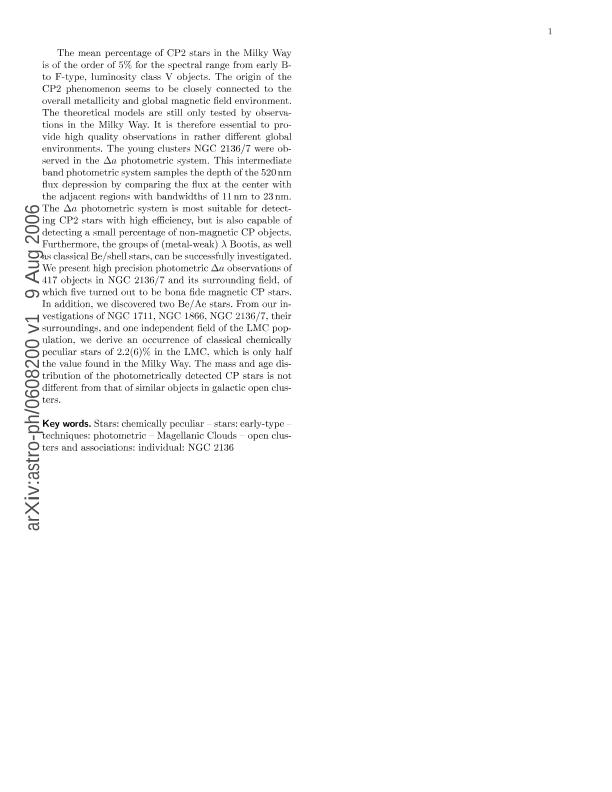Artículo
Chemically peculiar stars in the Large Magellanic Cloud
Fecha de publicación:
12/2006
Editorial:
EDP Sciences
Revista:
Astronomy and Astrophysics
ISSN:
0004-6361
Idioma:
Inglés
Tipo de recurso:
Artículo publicado
Clasificación temática:
Resumen
Context. The detection of magnetic chemically peculiar (CP2) stars in open clusters of extragalactic systems can give observational answers to many unsolved questions. For example, one can study the influence of different global as well local environments on the lack of and presence of peculiarities. Aims. The mean percentage of CP2 stars in the Milky Way is of the order of 5% for the spectral range from early B- to F-type, luminosity class V objects. The origin of the CP2 phenomenon seems to be closely connected to the overall metallicity and global magnetic field environment. The theoretical models are still only tested by observations in the Milky Way. It is therefore essential to provide high quality observations in rather different global environments. Methods. The young clusters NGC 2136/7 were observed in the Δa photometric system. This intermediate band photometric system samples the depth of the 520 nm flux depression by comparing the flux at the center with the adjacent regions with bandwidths of 11 nm to 23 nm. The Δa photometric system is most suitable for detecting CP2 stars with high efficiency, but is also capable of detecting a small percentage of non-magnetic CP objects. Furthermore, the groups of (metal-weak) λ Bootis, as well as classical Be/shell stars, can be successfully investigated. Results. We present high precision photometric Δa observations of 417 objects in NGC 2136/7 and its surrounding field, of which five turned out to be bona fide magnetic CP stars. In addition, we discovered two Be/Ae stars. Conclusions. From our investigations of NGC 1711, NGC 1866, NGC 2136/7, their surroundings, and one independent field of the LMC population, we derive an occurrence of classical chemically peculiar stars of 2.2(6)% in the LMC, which is only half the value found in the Milky Way. The mass and age distribution of the photometrically detected CP stars is not different from that of similar objects in galactic open clusters. © ESO 2006.
Archivos asociados
Licencia
Identificadores
Colecciones
Articulos(INSUGEO)
Articulos de INST.SUP.DE CORRELACION GEOLOGICA
Articulos de INST.SUP.DE CORRELACION GEOLOGICA
Citación
Paunzen, E.; Maitzen, H.M.; Pintado, Olga Ines; Claret, A.; Iliev, I.Kh.; et al.; Chemically peculiar stars in the Large Magellanic Cloud; EDP Sciences; Astronomy and Astrophysics; 459; 3; 12-2006; 871-874
Compartir
Altmétricas




